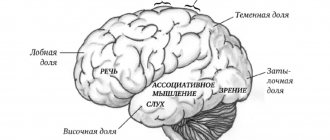Meaning of Perception
The sense organs are conductors and intermediaries between man and the outside world. It is they (visual, auditory, olfactory, tactile, gustatory) that provide a holistic perception of the environment, receiving irritant signals on the receptor surfaces. As a result, a person receives a complete understanding of objects and phenomena, their properties and qualities, and builds his “relationships” with them.
You may be interested in: Measuring the insulation resistance of an electric motor
In addition to sensations, the perception of the world is provided by thinking, speech, memory, therefore the perceptual activity of an individual is a complex cumulative process that depends on many individual properties of his psyche.
Aspects
Initially, the perceptual aspect manifests itself in the visual perception of the interlocutor . From the point of view of physiognomy, there is a certain connection between a person’s facial features and his psychological characteristics and behavioral characteristics.
When communicating with an opponent, we subconsciously or consciously analyze his appearance and make the first assumptions about his personality.
Next, a certain emotional interaction . If the conversation is negative, then, as a rule, a negative perception of the opponent’s personality is formed.
If the conversation is colored in positive tones, then affection for the person is more likely to appear.
This is where the main problem of the perceptual aspect lies; during initial acquaintance, we can draw incorrect conclusions about the personality of our partner only on the basis of a fleeting impression.
Reliable perception of another subject is possible only as a result of careful observation of him.
During communication, the words, gestures, manners, and facial expressions of the opponent are observed .
The received verbal and non-verbal information allows us to draw conclusions and come to an understanding of a person’s personality.
Properties of perception
You might be interested in: Psychology. Discretion is...
Channel PROGRAMMER'S DIARY
The life of a programmer and interesting reviews of everything. Subscribe so you don't miss new videos.
Perception ensures the functioning of various mental processes.
The perception of an object as a specific image, regardless of its location, provides such a property of perception as objectivity.
Simultaneously with the perception of an image (natural or, for example, drawn), its properties are also reproduced in consciousness.
- Such a property as integrity is expressed in the fact that an object is recognized regardless of whether all its parts are present, whether they are distorted, or whether their location in the object is incorrect.
- The meaningfulness of perception during the normal functioning of the human psyche can be traced in the fact that the observed object is correlated with a specific class, category (classified).
- Observed objects (or situations) are perceived as unchanged, even if the conditions of their demonstration change. So, for example, by feeling an object in complete darkness, a person can correctly determine what it is and name its main characteristics. This property of perceptual activity is called constancy.
- This property of perception, such as structure, allows you to perceive the environment reliably, even if sensations are not connected. The expression “glass surface of a lake” paints a specific image of a perfectly smooth, shiny, bluish-greenish surface of a reservoir.
- The individual state of mind necessarily influences perception: stormy weather delights some, but frightens others immensely and creates a state of panic. This property of perception is called apperception.
- Perception depends on the conditions in which it occurs. The perception of the same thunderstorm in a real situation and, for example, when watching a movie, will occur differently, which is where such a property of perception as contextuality manifests itself.
General characteristics of perception, perceptual image.
General characteristics of perception, perceptual image.
Perception is a holistic reflection of objects and phenomena of the objective world with their direct impact on our senses. Perception is an active process of reflecting the surrounding world, closely related to the activities performed by a person. An important component of perception are movements: movements of the eyes examining an object; movement of the hand feeling or manipulating an object; movements of the larynx that produce a hearing sound, etc.
Different types of perception have their own specific patterns. Along with them, there are also general patterns of perception: integrity, constancy, objectivity, structure, meaningfulness and generality, selectivity, apperception.
The perceptual system is a set of analyzers that provide a given act of perception) to compensate for these changes, we perceive surrounding objects as relatively constant in shape, size, color, etc.
17 Basic properties of perception: Integrity of perception is a property of perception, consisting in the fact that any object or spatial objective situation is perceived as a stable systemic whole. Constancy is the relative constancy of the perception of an image. The image of the size of an object on the retina of the eye when it is perceived from close and far distances will be different. Objectivity of perception means adequacy, correspondence of images of perception to real objects of reality. Thanks to the objectivity of perception, an object is perceived by us as a separate physical body. Structurality of perception is the property of human perception to combine influencing stimuli into holistic and relatively simple structures. The meaningfulness of perception is determined by understanding the connection between objects and phenomena through the process of thinking. Everything we perceive, we comprehend from the point of view of existing knowledge and accumulated experience. The meaningfulness of perception is manifested in recognition . To recognize an object means to perceive it in relation to a previously formed image. Selectivity is the preferential selection of some objects over others in the process of perception. Most often, selectivity of perception manifests itself in the preferential selection of an object from the background. Apperception. Dependence of perception on experience, knowledge, interests and attitudes of the individual. There are personal and situational apperception. Personal apperception determines the dependence of perception on the education and beliefs of the individual. Situational apperception is temporary, it affects emotions, attitudes, etc. So, for example, at night in the forest a stump can be perceived by a person as the figure of an animal and contribute to the appearance of corresponding emotions in him.
Classification of perception
The classification of perception is based on the following criteria: the leading analyzer in perception; the degree of organization; the direction of perception; the form of reflection. In accordance with which analyzer plays the leading role in a given perception, they distinguish: visual , auditory, tactile, kinesthetic, olfactory, taste perceptions . Any perception is determined by the activity of not one, but several analyzers. Depending on the purpose of perception, there are intentional and unintentional ones.
Intentional perceptions are characterized by the fact that they are based on a consciously set goal. They are associated with volitional efforts. Unintentional perceptions are those perceptions in which objects of the surrounding reality are perceived without a specifically set task. There is also no volitional activity in it, which is why it is called involuntary. According to the degree of organization, perceptions can be organized and unorganized. Organized perception is an organized, systematic perception of objects or phenomena of the surrounding world. Disorganized perception is the usual unintentional perception of the surrounding reality. According to the direction of perception, there are externally directed and internally directed . Externally directed perception
- this is the perception of objects and phenomena of the external world, and
internally directed - the perception of one’s own thoughts and feelings. According to the form of existence of matter reflected in perception, they distinguish: *perception of space, objects, phenomena of the surrounding world; *perception of a person by a person; *perception of time; *perception of movements.
22. perception of space: linear and aerial perspectives. Linear and aerial perspectives are essential when perceiving space .
With linear perspective, receding lines seem to converge at the horizon. Linear perspective is enhanced by the weakening of the difference between light and shadow, as well as the loss of individual small details. According to the laws of linear perspective, the sizes of objects decrease as they move away. Aerial perspective assumes different perceptions of objects of reality depending on a particular state of the air and the nature of the light source. The influence of the nature of the illumination source in aerial perspective is presented as follows. When moving away from the observer, the illuminated surfaces darken, and the shaded ones turn pale, becoming a pale gray silhouette. On the contrary, the closer they are to the observer, the more contrast the chiaroscuro is; illuminated surfaces appear lighter, and shaded surfaces appear darker. Spatial perspective is also determined by the density gradient. The ability to correctly assess the spatial relationships of objects is called the eye. There are static and dynamic eye gauges. Static eye meter - determining the size of stationary objects taking into account their distance. Dynamic eye - the ability to determine the distance between moving objects.
21. Perception of size, shape and volume of objects
The perception of the size, shape and volume of objects is due to the joint activity of visual, muscle and tactile sensations. The basis for the perception of the size of objects is the size of objectively existing objects, the images of which are obtained on the retina. The peculiarity of the structure of the human eye is such that the image of an object located at a far distance will be smaller than the image of an equal object located close to us. Shape perception is a complex process of visual perception in which eye movements are of great importance. In this case, optical data is processed by the brain in combination with data from the extraocular muscles of the eyes. When perceiving the shape of an object, its interaction with the background is essential. At the same time, the clarity of perception is facilitated by the sharp delineation of the contour of the object. Direct perception of the shape of an object and its relief occurs through touch, in which the skin and motor analyzers take part. of the three-dimensionality of objects based on binocular vision (vision using two eyes). With this vision, two images are obtained on the retina of the left and right eyes. Simultaneous vision of an object with both eyes creates the impression of the volume of the perceived object. When objects are significantly removed from us, when their images on both retinas lose their differences, we do not perceive the three-dimensionality of objects, but only think of them as three-dimensional on the basis of ideas preserved from viewing at a close distance. In this case, the laws of perspective and light and shade are of great importance. It is known that in a flat picture, guided by the rules of perspective and light and shade, it is possible to depict objects in such a way that they will be perceived as three-dimensional.
23. Depth perception is achieved primarily through binocular vision, i.e. seeing with two eyes. The perception of the distance of an object depends not only on the size of its image on the retina, but also on the strength of the tension of the eye muscles and the curvature of the lens. When perceiving distant objects, the lens becomes flat. When perceiving close objects, its curvature increases. This change in the curvature of the lens depending on the distance of the objects in question is called accommodation. We cannot correctly perceive the distance to objects significantly distant from us with the help of only one eye. Monocular vision allows us to correctly estimate distance only when objects are no more than 30 meters away from us. This is explained by the fact that accommodation (i.e., change in curvature) of the lens of the eye, which plays a major role in assessing distance with monocular vision, provides clear vision only at a close distance from us. In the perception of distance at distances to an object of more than 30 meters with binocular vision The mechanism of eye convergence plays an important role . Muscular-motor sensations during eye convergence allow us to judge which objects are closer and which are further from us. The processes of accommodation and convergence occur involuntarily. A person does not think about the need to focus the image; this process occurs automatically. He, as a rule, does not notice that when moving his gaze from close to distant objects (or vice versa), significant changes occur in the organ of vision. Nevertheless, these changes can be observed in the following simple experiment. Close one eye and look into the distance with the other, at the horizon line, then place a pencil or pen in front of this eye at a distance of 30–40 cm. If you focus your attention on the horizon line, the horizon will be visible clearly and clearly, but the pencil will be blurry and blurry. When you turn your attention to the pencil, the pencil will be clearly visible, but the horizon will blur and be unclear.
24. Perception of objects: perceptual activity Techniques for image recognition: 1) simplification of the image 2) creation of competing images 3) creation of images devoid of a specific meaning. One of the main features of all phenomena of perception is the tendency to selectively highlight and organize data received by the senses. When interpreting visual information We identify any groupings as units, each of which has a distinctive feature. Preventing information organization is difficult. The interpretation of sensory data is governed by the following rules: 1) identification of features 2) interpretation of features as a whole . The identification of features of objects when interpreting sensory data is based on: 1) continuous eye movement 2) the emergence of successive images . Perceptual tasks are the demands that an activity makes and perceives . To perceive means to solve one or another perceptual problem. In order for a perceptual task to be solved, the necessary perceptual actions . Perceptual actions are derived from practical actions. Perceptual actions are based structured processes that ensure the construction of an object image. Perceptual actions are implemented using a set of perceptual operations. ACTIVITY à ACTION à OPERATION . An important factor in the development of a perceptual image in children is the development of sensory standards. A special place in the formation of a perceptual image is occupied by the formation of operational units of perception. The operational unit of perception is the identification of single objects in the perceptual field. The development of perception is associated with a change in the units of the perceptual image. Opera. The images of objects gradually become unified. Thanks to this, the possibility of instantaneous perception arises.
25. The perception of a person by a person is a concept used in social psychology to designate the process of constructing an image of another person, which unfolds during direct communication with him. Includes all levels of mental reflection. This process has special time characteristics. Initially, when perceiving a stranger, the main attention is paid to his appearance (facial expression, eyes, hairstyle, expressive body movements). As the process of perceiving a person unfolds, ideas about his character traits, abilities, interests, and emotional states are formed, which are very often grouped around the professional characteristics of the individual. There are four main strategies in perceiving another person: 1. Analytical, in which each element of appearance is interpreted as a form of manifestation of a personality trait (presence of glasses - scientist); 2. Emotional, in which directly non-perceivable personality traits are interpreted depending on overall attractiveness or unattractiveness; 3. Perceptual-associative, in which the properties of another person who is outwardly similar are attributed; 4. Social-associative, in which the properties of the social group to which a person can be attributed are attributed.
26. Perception of Time Perception of time is a reflection of the objective duration, speed and sequence of phenomena of reality. At the heart of V. century. lies the rhythmic alternation of excitation and inhibition in the cerebral hemispheres. In V. century. Various analyzers are involved, the most accurate differentiation of time intervals is provided by kinesthetic and auditory sensations. I.M. Sechenov called hearing a time meter, and auditory memory the memory of time. The subjective perception of long periods of time is largely determined by the nature of the experiences with which they were filled and the emotional state of the subject. Time filled with interesting, deeply motivated activity seems shorter than time spent doing nothing. However, in a retrospective report, the ratio may. the opposite: time spent in idleness and boredom seems shorter when remembered after some time. Positive emotions give the illusion of rapid passage of time, they deny. — subjectively they stretch the time intervals somewhat. At the cultural level, L. N. Gumilyov identified 7 types of time counting and relationships to it: atemporality, phenological and cyclic calendars, living chronology and linear counting, quantization and relativization of time.. In his long-term studies, Sov. psychologist D. G. Elkin showed that a person, throughout his cultural development, gradually assimilates social standards of duration that make up a system of time scales and measures. Such mediation allows not only to more accurately evaluate various intervals, but also to go far beyond the capabilities of direct V. century. T. o., V. v. is based, on the one hand, on the signal value of the temporal characteristics of one’s own voluntary movements and the rhythms of involuntary vegetative processes (“biological clock”), as natural measures by which time is assessed; on the other hand, on the historically developing system of social standards and technical means. See Perceptions of time disturbance. (B.M.)
27 . The perception of motion is a reflection of a change in the position of an object in space and time, i.e. its direction and speed. It is the result of the simultaneous reflection of both an object and an event. Currently, two hypotheses that explain the mechanism of motion perception are most widely recognized in psychology: 1. The perception of motion is caused by the movement of images of objects on the retina. This hypothesis better explains the so-called “real (physical) movement,” the mechanism of which is based on the stroboscopic effect. The image of an object appears on the retina as the perceptual field of a static eye. Then, images of moving objects move across the retina in accordance with the animation effect. However, the above hypothesis is not able to explain, for example, the phi phenomenon , i.e. M. Wertheimer's pseudo-motion effect . Alternating flashes of semaphore lights are perceived by us as moving lights. In this case, the human eye is moving, but the real object, on the contrary, is static. It is impossible to distinguish a really moving object from a really stationary object (the illusion of the moon moving against the background of moving clouds).2. The perception of motion is the result of eye movement. Thus, in an experiment by the American psychologist L. Matin, subjects were instilled with a chemical substance that caused temporary paralysis of the eye muscles. As a result, moving objects were perceived by a static eye, and the subjects experienced a “jumping world” effect. Based on this hypothesis, it is difficult to explain provoked movement, when a moving object causes the movement of another – stationary – object. For example, an illustration of the theory of relativity: a moving train outside the window and you inside a stationary carriage. You can also cite the results of a study of autokinetic (self-regulating) movement. After some time, a stationary luminous point in a dark room is perceived by the subjects as moving. At the same time, the “naive” subject sincerely believes that the luminous point is moving, while it remains motionless. Apparently, the features of our perception in this case can be explained on the basis of the law of “figure and background” . Movement occurs when an object is perceived as a figure relative to the background created by another object. Therefore, the reflection of the distance between objects (i.e. eye movement) and its movement along the retina (disappearance of the autokinetic effect when we fix the image of an object on the retina) is important
28. Apperception - the influence on the perception of objects in the surrounding world of the individual’s previous experience and attitudes. The term “apperception” was introduced by G. Leibniz, who distinguished perception as a vague presentation of some content and apperception as a clear and distinct, conscious vision of this content by the soul. After G. Leibniz, the concept of apperception was used primarily in German philosophy (I. Kant, I. Herbart, W. Wundt, etc.), where it was considered a manifestation of the spontaneous activity of the soul and the source of a single stream of consciousness. W. Wundt turned this concept into a universal explanatory principle. In Gestalt psychology, apperception was interpreted as the structural integrity of perception. The role of attitudes This role is especially significant when forming the first impression of a stranger. So, in the experiment, two groups of student subjects were shown a photograph of the same person, but one group was told that this was an image of a dangerous criminal, and the second group that this was an image of a famous scientist. In the subsequent verbal portrait of the object of perception, the same features were characterized in different ways: in one case, deeply sunken eyes allegedly testified to hidden anger, and in the other, to the depth of thought, etc. Stereotyping in some cases leads to a certain simplification of the cognition process each other's people. In other cases, stereotyping leads to the formation of prejudice. If a person's perception is built on the basis of past experience, and this experience was negative, then any subsequent perception of people of the same group can be colored by hostility, harming the interaction of people. Thus, with the aggravation of ethnic conflicts in modern conditions, ethnic stereotypes are very common among the population, when, based on limited information about individual representatives of any ethnic groups, biased conclusions are drawn about the entire group.
29. Attention is the selective focus of perception on a particular object. Types of attention Depending on the presence of a conscious choice of direction and regulation, they are distinguished: Involuntary attention (passive) A type of attention in which there is no conscious choice of direction and regulation. It is based on unconscious human attitudes. As a rule, short-term, quickly turning into arbitrary. The occurrence of involuntary attention can be caused by the peculiarity of the influencing stimulus, and also be determined by the correspondence of these stimuli to past experience or the mental state of a person. Voluntary attention Its occurrence is historically associated with the labor process. The psychological feature of voluntary attention is that it is accompanied by the experience of greater or lesser volitional effort and tension, and long-term maintenance of voluntary attention causes fatigue, often even greater than physical tension. Post-voluntary attention A type of attention in which there is a conscious choice of the object of attention, but there is no tension characteristic of voluntary attention. Associated with the formation of a new attitude, associated to a greater extent with current activity rather than with a person’s previous experience (as opposed to involuntary). Properties of attention: Concentration ( Concentration of attention is understood as the intensity of concentration of consciousness on an object) Volume (a number of objects can be perceived simultaneously and with equal clarity) Stability ( the opposite of it is lability - characterized by the duration during which concentration of attention is maintained at the same level .) Switchability (changing the direction of consciousness from one object to another). Distribution ( Ability to hold several heterogeneous objects or subjects in the spotlight)
35. Voluntary (intentional) attention is an active, purposeful concentration of consciousness, maintaining the level of which is associated with certain volitional efforts necessary to combat stronger influences. Voluntary attention depends on the state of the nervous system and is determined by motivational factors: the strength of the need, attitude towards the object of cognition and attitude. This type of attention is necessary for mastering skills; performance depends on it. Based on this, voluntary attention is distinguished by the following characteristics : - Purposefulness .
Voluntary attention is determined by the tasks that a person sets for himself in a particular activity
. -Organization .
With voluntary attention, a person prepares in advance to be attentive to one or another object, consciously directs his attention to this object, and demonstrates the ability to organize the mental processes necessary for this activity
. -Increased stability .
Intentional attention allows you to organize work for a more or less long time; it is associated with the planning of this work. Voluntary attention requires significant energy expenditure, and therefore, with a narrow focus on one, especially insignificant object, tires a person faster than involuntary attention.
30. Physiological foundations of attention From a physiological point of view, attention is nothing more than the nervous activity of a certain part of the cerebral cortex, which at a given moment and under given conditions has optimal (i.e., the best under given circumstances) excitability, while the rest areas of the cortex are in a state of more or less reduced excitability. In areas of the cortex with optimal excitability, new conditioned reflex connections are easily formed and differentiations are successfully developed. This explains the clarity and distinctness of mental processes accompanied by attention. Areas of the cortex with optimal excitability are the creative department of the cerebral hemispheres at the moment. They constantly move throughout the entire space of the cerebral hemispheres, depending on the stimulation received during this activity. Accordingly, areas with reduced excitability also change in size and constantly move in the cortex. To explain the physiological mechanisms of attention, the principle of dominance put forward by A.A. Ukhtomsky is of certain importance. At any given moment, in the cerebral cortex there is an area (focus) with increased nervous excitability, dominant (dominant) over the remaining parts of the cortex. Under certain conditions (optimal degree of excitation), it is enhanced by other nerve impulses, usually causing other reactions. For example, rhythmically weak sounds, which under normal conditions evoke an orienting reflex, in the presence of a dominant focus associated with the reading process, contribute to its intensification and, thus, increase the concentration of attention. However, at the maximum degree of nervous excitation in the dominant focus, side impulses not only do not contribute to its strengthening, but also cause parabiotic inhibition in it and, thus, lead to disruption of concentration.
31. Theories of attention in Western psychology Motor (motor-emotional) theory of attention T. Ribot . believed that involuntary and voluntary attention is directly determined by the intensity and duration of emotional states associated with the object of attention. Attention, according to the French psychologist, is a psychological immobility that contradicts the normal flow of life processes. E. Titchener introduced an additional metaphor to explain the phenomenon of attention - the wave metaphor . Thus, he emphasized the intermittent nature of attention, i.e. argued that at any given time only one content reaches the “crest of the wave of attention” (apperception). He described the phenomenon of “ accommodation ” of attention - the preferential apperception of that content that is better consistent with the previous one. E. Titchener also created one of the earliest classifications of attention. According to the degree of voluntariness, he distinguished primary (involuntary) and secondary attention. In the case of primary attention, new unexpected or, on the contrary, contents that are firmly connected with the flow of our thoughts literally “take our consciousness by storm.” We are able to maintain secondary attention only with the help of effort. W. Wundt’s is the measurement of the volume of consciousness: about six associatively connected objects. To measure the volume of consciousness, he used a melodic series, including a different number of bars. V. Wundt suggested that only the beat perceived at the moment is in the focus of consciousness, and all the others are held due to associative connections with the focus. To describe the content of consciousness (and attention), W. Wundt used the terms proposed by G. Leibniz : “ perception ” and “ apperception ”. He called perception the entry of content into consciousness, apperception - focusing attention on a specific object, i.e. its entry into the focus of consciousness. According to V. Wundt , our ability to realize is not constant and depends on the nature of the perceived material. If we perceive a set of random elements, the volume of consciousness and attention coincide. The boundary of consciousness becomes the boundary of attention (attention = consciousness).
34. Involuntary (unintentional) attention occurs without a person’s intention to see or hear anything, without a predetermined goal, without effort of will. Involuntary attention is caused by external reasons. The features due to which external objects can attract our attention are as follows. Stimulus intensity .
An object that is stronger than another, simultaneously acting on the body, is more likely to attract attention to itself.
Novelty, unusualness of objects. Objects that do not stand out for their intensity attract attention if only they are new to us. Abrupt changes
, as well as
the dynamism
of objects
, are often observed during complex and long-lasting actions, for example, when watching sports.
Unintentional attention is characterized by the following main features: - With unintentional attention, a person does not first prepare for a given perception or action. - Unintentional attention occurs suddenly, immediately following the impact of irritation and in its intensity is determined by the characteristics of the irritations that caused it. Unintentional attention is fleeting: it lasts as long as the corresponding stimuli act, and if the necessary measures are not taken to consolidate it in the form of intentional attention, it stops. 32. Theories of attention in Russian psychology Russian psychologist N.N. Lange defined attention as “a purposeful reaction of the body that instantly improves the conditions of perception.” It is the criterion of instantaneity that makes it possible to separate attention from other adaptive reactions of the body. According to the scientist, the act of attention has three phases: primary attention, a reaction that improves perception, and improved perception itself. The second name of this theory - the concept of volitional attention - becomes obvious if we turn to the one proposed by N.N. Lange classification of types of attention. Thus, reflexive attention is devoid of an emotional component and is carried out automatically (for example, pupil dilation in a dark room). N.N. Lange believed that a weak sensation, connecting with a vivid memory image, acquires an intensity sufficient for the emergence of the process of perception, which is difficult in dementia. This is why we often see or hear what we want, and not what is actually happening. The tradition of considering attention together with perception has not lost its relevance and is presented in many foreign textbooks on psychology. Concepts by P.Ya. Halperin are reduced to the following: 1. Attention is one of the moments of orientation-research activity. It is a psychological action aimed at the content of an image, thought, or other phenomenon existing at a given moment in the human psyche.2. By its function, attention is the control of this content. Every human action has an orienting, performing and control part. This latter is represented by attention as such.3. Unlike other activities that produce a specific product, the activity of control, or attention, does not have a separate, special result.4. Attention as an independent, concrete act is highlighted only when the action becomes not only mental, but also abbreviated. Not all control should be considered attention. Control only evaluates the action, while attention helps improve it.5. In attention, control is carried out using a criterion, measure, sample, which creates the opportunity to compare the results of an action and clarify it.6. Voluntary attention is systematically carried out attention, i.e., a form of control carried out according to a pre-drawn up plan or pattern.7. In order to form a new method of voluntary attention, we must, along with the main activity, offer a person the task of checking its progress and results, developing and implementing an appropriate plan.8. All known acts of attention, performing the function of control, both voluntary and involuntary, are the result of the formation of new mental actions.
33 . Properties of attention. Focus is maintaining attention on one object or one action while distracting from everything else. Concentration of attention depends on age and work experience, as well as on the state of the nervous system. An indicator of concentration and attention is its resistance to interference, determined by the strength of an extraneous stimulus that can distract attention from the subject of activity. Sustainability of attention is the duration of concentration on an object or phenomenon or maintaining the required intensity of attention for a long time. Depends on the individual physiological characteristics of the body, on the mental state, on motivation, on external circumstances. Distractibility is the opposite of stability. In contrast to switching, which is done intentionally and voluntarily, attention is always distracted involuntarily and more often when exposed to strong extraneous stimuli. The intensity of attention is characterized by a relatively greater expenditure of nervous energy to perform a given type of activity .
in connection with which the mental processes involved in this activity proceed with greater clarity, clarity and speed. The intensity of attention is expressed in great concentration and allows us to achieve better quality of the actions performed.
Fluctuations of attention are expressed in the periodic change of objects to which it is drawn. Fluctuations in attention are explained by fatigue of the nerve centers during activities performed with intense attention. The span of attention is characterized by the number of objects or their elements that can be simultaneously perceived with the same degree of clarity and distinctness at one moment .
The more objects or their elements are perceived at one moment, the greater the volume of attention; The average volume of attention is 5±2 units in children, 7±2 units in adults.
Distribution of attention is the ability of an individual to simultaneously perform two or more types of activities. Switchability of attention is the ability to quickly switch off from certain types of activities and engage in new types of activities that correspond to changed conditions.
The ability to switch attention depends on the mobility of the nervous system. Depends on temperament. 36. The characteristic of post-voluntary attention is already contained in its very name: it occurs after voluntary attention, but is qualitatively different from it. When problems appear when solving a problem
The nature of the perception process
The external environment and its individual objects and phenomena influence the senses through analyzers. Their complex interaction ensures the flow of information into the brain centers and its processing.
Complex analysis and synthesis of external data ensure the creation of a holistic image: external and hidden, internal properties and qualities of the object are determined. That is, a number of its characteristics are formed.
The process of perceiving the same object is unique, as is its mental image, since they depend on the individual mental and physiological characteristics of a person. Life principles, views, motives, interests, preferences as the results of upbringing and lifestyle certainly determine the assessment of the properties and qualities of an object. For example, the same work of art can be emotionally assessed by different observers as “strikingly beautiful” and… “disgusting.”
Teachers
A teacher's perceptual abilities are the ability to:
- perceive the student’s psychological state;
- keep the whole class and a specific student in sight at the same time;
- differentiate the characteristic features of a student from the manifestation of a momentary state;
- evaluate students’ activities based on the results of completion (positive, negative, neutral), voicing a comprehensive analysis.
It should be noted that the requirements for the skills, abilities and competence of a teacher vary depending on the field of activity: school, college, university. Different researchers classify teacher competencies in different ways. The conclusion about the importance of a person’s pedagogical orientation in activity remains unchanged (at a high level of development of general and special abilities).
Larisa Maksimovna Mitina in her research highlights the reflexive-perceptual abilities of a teacher and their components:
- pedagogical reflection;
- pedagogical tact;
- pedagogical orientation.
All of the above skills are components of pedagogical culture. Its structure includes significant qualities:
- professional and personal;
- professional knowledge;
- professional skills;
- active pedagogical position;
- experience of creative activity.
The value is the child - his development, learning, protection and support of dignity. The developed perceptual abilities of a teacher are the foundation for joint directed activities of teacher and student within the framework of pedagogical culture.
The structure of perceptual action
Any process consists of individual operations - actions. The quality of the result depends on whether they are arranged in the correct sequence and performed without errors.
The process of perception includes a number of perceptual actions, this is due to the fact that a person needs:
Perceptual action is several operations to transform sensory information.
Detection—detects the presence of a cognitive stimulus.
Discrimination - a perceptual standard is formed.
Next, the identification process takes place based on such actions as comparison and identification. The received image is compared with the one in memory and belongs to a certain class of objects, that is, it is categorized.
Mastering perceptual actions is a very difficult and lengthy process for a person, requiring special training.
Mechanisms
The mechanisms of the perceptual side of communication suggest:
- Reflection .
The ability to evaluate one’s actions and actions, draw conclusions from the current situation and understand the desired paths for further developments. During communication, we try to imagine the impression we make on the interlocutor. If the result does not meet expectations, reflection occurs. - Identification . It implies likening oneself to another individual. During a dialogue, we put ourselves in the place of another person and try to look at the situation through his eyes, through the prism of his worldview.
- Empathy . This is the ability to empathize and share emotions. The greatest degree of empathy is characteristic of people with a fine mental organization and a developed system of moral values. They know how to clearly assess the state of other people by observing their actions, words, gestures and facial expressions.
- Anthropological stereotypes . The assessment of the internal, psychological qualities of a person is based on the perception of the anthropological characteristics of a person. For example, a person decides for himself that the deep-set eyes of his interlocutor indicate a secretive and tough character, and pampered hands speak of laziness.
- Social stereotypes. The partner’s personality is assessed on the basis of available information about his social status, financial situation, position, etc.
- Aesthetic stereotypes. Judgment about a person is based on his external attractiveness.
For example, a beautiful and smiling girl is perceived by interlocutors as a kind and open person, although her external attractiveness may in no way reflect the essence of her personality. - Projection . Endowing a communication partner with those qualities that are inherent in the subject himself. This can happen consciously or unconsciously.
- Casual attribution. Interpretation of the words and actions of another person based on one’s own observations and assumptions.
When and how are perceptual skills formed?
The development of perceptual actions guarantees a person a full knowledge of the world around him and maximum adaptation to it. Sensory perception of objects, actions with them, observations expand and improve, replenish the personal experience of the individual.
The formation of perceptual actions begins in children at 2-3 years of age. Senior preschool age and school age are particularly important periods in this regard. The development of children's perceptual actions occurs in the conditions of specially organized systematic and consistent classes in kindergarten and school.
Children, under the guidance of educators and school teachers, discover the objective world for themselves, becoming acquainted with various objects and their properties, learning to analyze them, identifying the most significant ones, which become sensory standards. They are complemented by a system of motor, or motor, skills, which provides the child with a comprehensive “discovery of the world.” Modeling (drawing, manual labor, playing with building materials) allows you to transform mental images into real ones.
Social significance of the skill
A person gets to know himself, the people around him and the world through communication (verbal and non-verbal). On this basis, the socio-perceptual abilities of the individual are formed and developed. Understanding of the emotional experiences of the interlocutor is formed in preschoolers in the process of communication with significant adults and peers. This necessary component of communication is formed gradually, unconsciously, as an adaptation to the surrounding reality.
Communication is a process consisting of social perception, interaction (exchange of actions) and communication. The exclusion of any component leads to misunderstanding, misinterpretation of intentions, and distortion of contact between interlocutors. If adults consciously work on communication (exchange of information) and interaction almost all their lives, then with perception things are more complicated.
The formation and development of social-perceptual abilities is influenced by the child’s experience of family situations and associated emotional states. At the same time, the emotions shown by both parents have a great influence on the child. As a rule, the wider the children, the more successfully they recognize the emotional state of their interlocutor.
If it so happens that an adult’s perceptual abilities are not formed at an insufficient level and this fact is a significant obstacle to establishing and maintaining contacts, then a lot of time and effort will have to be devoted to eliminating the problem. At the moment, special computer programs have been created to help correct the perception of the interlocutor’s emotions based on facial expressions (more precisely, facial microexpressions).
The problems of interpreting a person’s emotional states are described in his books by a famous psychologist. Since the occurrence of such a problem can significantly ruin a person’s life, special courses on teaching communication, methods, lists of recommendations and exercises are being created.
Note to parents
Forming a system of perceptual actions in a child is primarily the concern of parents. Firstly, they need to closely monitor the health of the baby’s sensory organs, otherwise their insufficient functioning will make it difficult to perceive the features of objects of cognition. Secondly, one should not rely only on educators and teachers: the development of perceptual actions is one of the goals of family education in the early stages of a child’s life. To do this, we need to help him thoroughly examine objects (what they sound like, how they are structured, what parts they are made of, what they feel, taste and smell), teach him how to operate them, and enrich his vocabulary with nouns (what is this?), adjectives (which one? ), verbs (what does it do?).
Children should be shown pictures and techniques of drawing, modeling, design, and practice comparing objects according to different parameters.
The main method of teaching toddlers and young children is play. Children love playing and doing activities together with their parents. Emotional substantive communication with them stimulates the child’s development of perceptual actions.
Source
Development programs and methods
All programs and methods for developing perceptual abilities are divided into three groups:
- complexes for children (and adults) with developmental problems;
- for children (and adults) with normal development;
- for the gifted.
They take into account not only intellectual, but also age and gender characteristics of the development of children, adolescents and adults. To determine the appropriate option, you need to read the explanatory note. It describes in detail the target audience, goals and objectives of the methodology or program.
The role of perceptual abilities in the life of an adult
In the structure of general personality characteristics, perception is closely related to attention, thinking, cognition, sensation and imagination. In everyday life, people with developed perceptual abilities compare favorably with their antipodes. This is expressed in volume, accuracy, completeness and speed of perception, and the emotional coloring of the process. Such people are easy to train, adapt well to the environment, have a creative attitude to work, have their own point of view on current events, and value time.
Perhaps, knowing this pattern, employers, along with professional tests, would also conduct tests for the development of perceptual abilities. Perception also plays an important role in a person’s personal development. The solution to many problems lies in the sphere of completeness and accuracy of perception. That’s why there are sayings “the box just opened” or “it’s hard to find a black cat in a dark room if it’s not there.”











